Material Deformation Behavior in T-Shape Hydroforming of Metal Microtubes
Abstract
1. Introduction
2. Materials and Methods
2.1. Overview of MTHF System
2.2. Materials Used and Experimental Methods
2.3. FEM Model
3. Results and Discussion
3.1. Deformation Behavior in T-Shape MTHF Process
3.2. Effect of Lubrication/Friction on Bulge Height and Material Behavior in Micro-T-Shape Forming
3.3. Effect of Tube Length on Hydroformability in T-Shape MTHF
3.4. Microforming Defects and Process Windows
3.5. Theoretical and Experimental Bulge Height of T-Shape and Cross-Shape MTHF
3.6. Microstructure of Microtube in T-shape MTHF
4. Conclusions
- The deformation behavior and forming characteristics of T-shape MTHF were clarified from experiments and FEM. The two sets of results showed relatively good agreement. In a late forming stage, a discrepancy between experimental and simulated bulge height results was seen and is thought to be due to the occurrence of irregular deformation at the bottom opposite the bulge in the experiment, and the experimental bulge height was larger than the FEM result.
- The hydroformability of C1220 copper microtubes is lower than that of SUS304 because the SUS304 microtubes having high buckling resistance and the occurrence of bottom buckling in the T-shape MTHF process being suppressed.
- The microtube length, which is related to the friction resistance, greatly affects the hydroformability. Even when T-shape MTHF of a short microtube is successful, for a longer tube, even with an extremely good friction/lubrication state, the flow of material into the die cavity becomes difficult, and the process cannot be successful. Compared with cross-shape MTHF, the hydroformability (bulge height) in T-shape MTHF is superior, and increased bulge height can be obtained. Since the tube material in T-shape MTHF flows asymmetrically in one direction into the die cavity, there is a high possibility of buckling deformation easily occurring at the bottom of the bulge, and the buckling region in the process window becomes wider under low internal pressure, and the success region moves to one of higher internal pressure.
- Lubrication and friction between the tube and the die greatly affect the hydroformability (bulge height) of the microtube. When the friction resistance increases, the amount of material flowing into the die cavity is restricted and decreases, and then the bulge height decreases. Correspondingly, the microtube greatly thickens in the vicinity of its end.
- The asymmetric material behavior in T-shape MTHF causes a variety of undesired deformation defects in low internal pressure loading paths. This is because the plastic flow into one side of the bulge die cavity causes irregular complex deformation behavior, whereby a variety of forming defects easily occur in the early stages of T-shape MTHF compared with cross-shape MTHF. A featured typical forming defect for T-shape MTHF is buckling/folding at the bottom of the bulge.
- The success region in the process window for T-shape MTHF shifts toward higher internal pressure compared with that for cross-shape MTHF. There were many defects in the low internal pressure region, and the area where the microtube could be deformed was also narrowed. Since the thickening of the wall was greater than that in cross-shape forming, the forming efficiency considering the bulge height deteriorated by approximately 25%.
- From observation of the metal microstructure, 20 or more fine grains arranged in the thickness direction were observed for the C1220 copper microtube. The deformation behavior of a T-shape tube was roughly estimated by FEM analysis that did not consider the structural size effect. The microstructure in buckling and folding wrinkles that occurred at the bottom opposite the bulge showed a decrease of approximately 14% in average grain size compared with the surrounding grains. This refinement could be caused by the difference in the buckling and folding behavior in FEM described in Equation (1) above.
Author Contributions
Funding
Acknowledgments
Conflicts of Interest
References
- The Japan Society for Technology of Plasticity. Tube Hydroforming Keiryoukanotameno-Seikei-Gijutsu, 1st ed.; Morikita-Shuppan: Tokyo, Japan, 2015; pp. 1–288. [Google Scholar]
- Manabe, K.; Fuchizawa, S. Tube Forming Technology: Toward the Highest Card for Weight Savings. J. Jpn. Soc. Technol. Plast. 2011, 52, 33–41. [Google Scholar] [CrossRef]
- Geiger, M.; Kleiner, M.; Eckstein, R.; Tiesler, N.; Engel, U. Microforming. CIRP Ann. 2001, 50, 445–462. [Google Scholar] [CrossRef]
- Hartl, C.; Anyasodor, G. Experimental and numerical investigations into micro-hydroforming processes and machine design. Steel Res. Int. 2010, 81, 1193–1196. [Google Scholar]
- Zhuang, W.; Wang, S.; Lin, J.; Hartl, C. Experimental and numerical investigation of localized thinning in hydroforming of micro-tubes. Euro. J. Mech. A/Solids 2011, 31, 67–76. [Google Scholar] [CrossRef]
- Ngaile, G.; Lowrie, J. New micro tube hydroforming system based on floating die assembly concept. Trans. ASME J. Micro Nano-Manuf. 2014, 2, 041004. [Google Scholar] [CrossRef]
- Manabe, K. Micro forming processing of metal tubes. B. Jpn. Soc. Technol. Plast. 2019, 2, 8–13. [Google Scholar]
- Shirayori, A.; Ando, T.; Narazaki, M.; Usui, M. Effect of Initial thickness on cross-shaped-tube hydroforming of small-diameter tubing. J. Jpn. Soc. Technol. Plast. 2013, 54, 988–992. [Google Scholar] [CrossRef][Green Version]
- Shirayori, A.; Ando, T.; Usui, M.; Narazaki, M. Effect of Initial Thickness on Cross-Shaped Tube Hydroforming of Small Diameter Tubing. In Proceedings of the 6th International Conference on Tube Hydroforming (TUBEHYDRO 2013), Jeju, Korea, 25–28 August 2013; pp. 64–67. [Google Scholar]
- Yasui, H.; Yoshihara, S.; Yamada, R.; Ito, Y. Deformation Behavior on Small-Diameter ZM21 Magnesium Alloy Tube in Warm Tube Hydroforming. J. Jpn. Soc. Technol. Plast. 2019, 60, 346–351. [Google Scholar] [CrossRef]
- Mori, S.; Sato, H.; Itai, K.; Manabe, K. Development of microtube hydroforming system and its application to cross-shape microtube. J. Jpn. Soc. Technol. Plast. 2017, 58, 72–77. [Google Scholar] [CrossRef][Green Version]
- Jirathearanat, S.; Hartl, C.; Altan, T. Hydroforming of Y-shapes—product and process design using FEA simulation and experiments. J. Mater. Process. Technol. 2004, 146, 124–129. [Google Scholar] [CrossRef]
- Manabe, K.; Sato, H.; Itai, K.; Vilotic, M.; Tada, K. Factors influencing the forming characteristics in micro tube hydroforming by ultra high-forming pressure. Procedia Eng. 2017, 207, 2334–2339. [Google Scholar] [CrossRef]
- Mori, S.; Itai, K.; Sato, H.; Tada, K.; Manabe, K.; Takahashi, S. Micro Tee Hydroforming of Copper Tube. In Proceedings of the 68th Japanese Joint Conference for the Technology of Plasticity, Fukui, Japan, 9–12 November 2017; pp. 409–410. [Google Scholar]
- Miyagawa, M.; Back, C. The buckling of the circular cylindrical shells under uniaxial compression and nose gorming. J. Jpn. Soc. Technol. Plast. 1962, 3, 397–405. [Google Scholar]
- Geckeler, J.W. Plastic buckling of the wall of hollow cylinders and some other folding phenomena on trays and sheets. J. Appl. Math. Mech. 1928, 8, 341–352. [Google Scholar]
- Vollertsen, F.; Hu, Z. Tribological size effects in sheet metal forming measured by a strip drawing test. CIRP Ann. 2010, 55, 1193–1196. [Google Scholar] [CrossRef]
- Putten, V.K.; Franzke, M.; Hirt, G. Size effect on friction and yielding in wire flat rolling. In Proceedings of the 2nd International Conference on New Forming Technology, Bremen, Germany, 20–21 September 2007; pp. 583–592. [Google Scholar]
- Shirayori, A.; Tamanoi, S.; Narazaki, M. Elementary Analysis Modeling for Branch Forming of Small Diameter Thick-Walled Tube. In Proceedings of the 63rd Japanese Joint Conference for the Technology of Plasticity, Kitakyushu, Japan, 4–6 November 2012; pp. 183–184. [Google Scholar]
- Fuchizawa, S.; Kitamura, K.; Narazaki, M.; Sukimoto, M.; Watanabe, I. Deformations of aluminum alloy tubes under forming of T-fitting. J. Jpn. Soc. Technol. Plast. 1995, 30, 80–86. [Google Scholar]
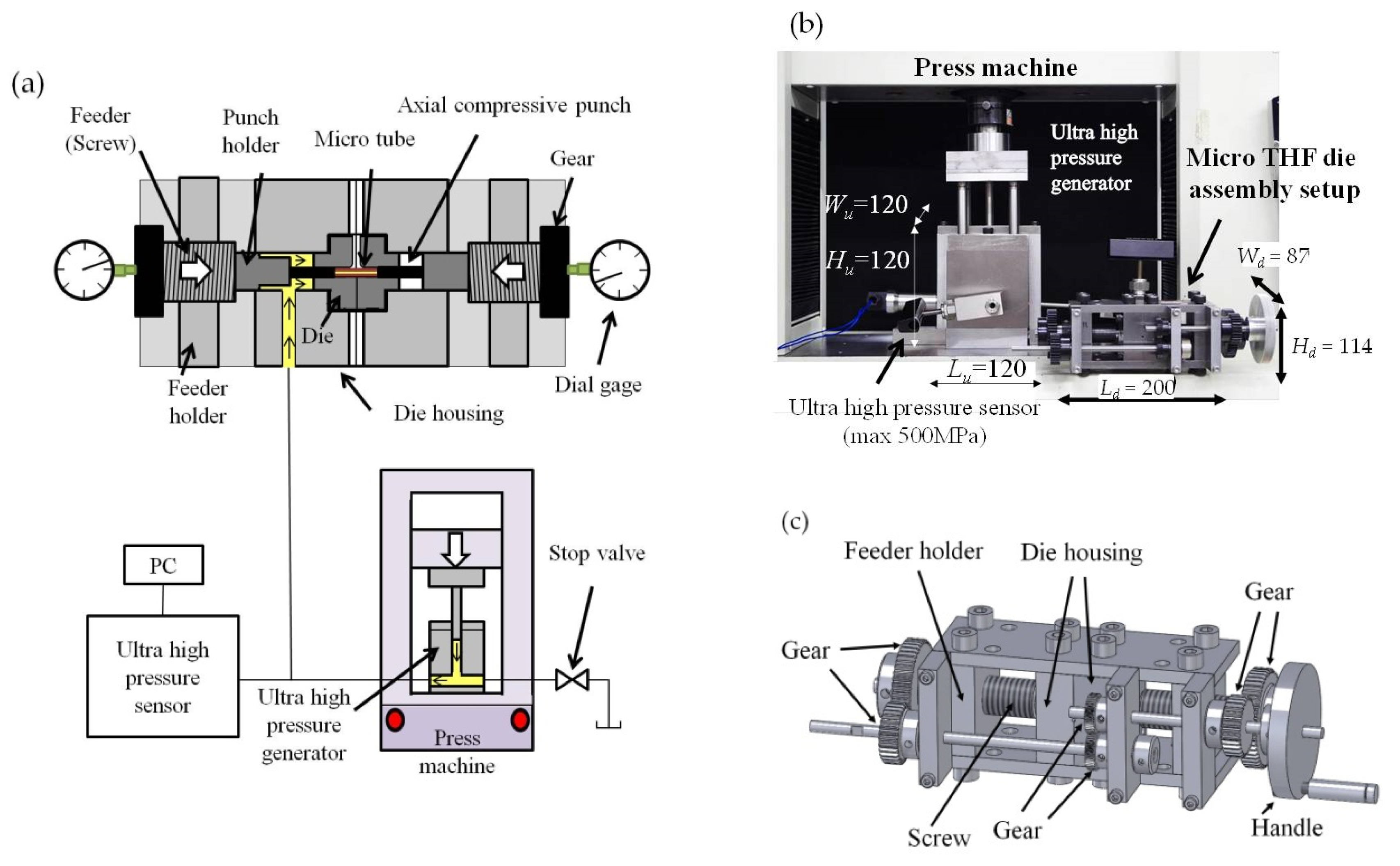
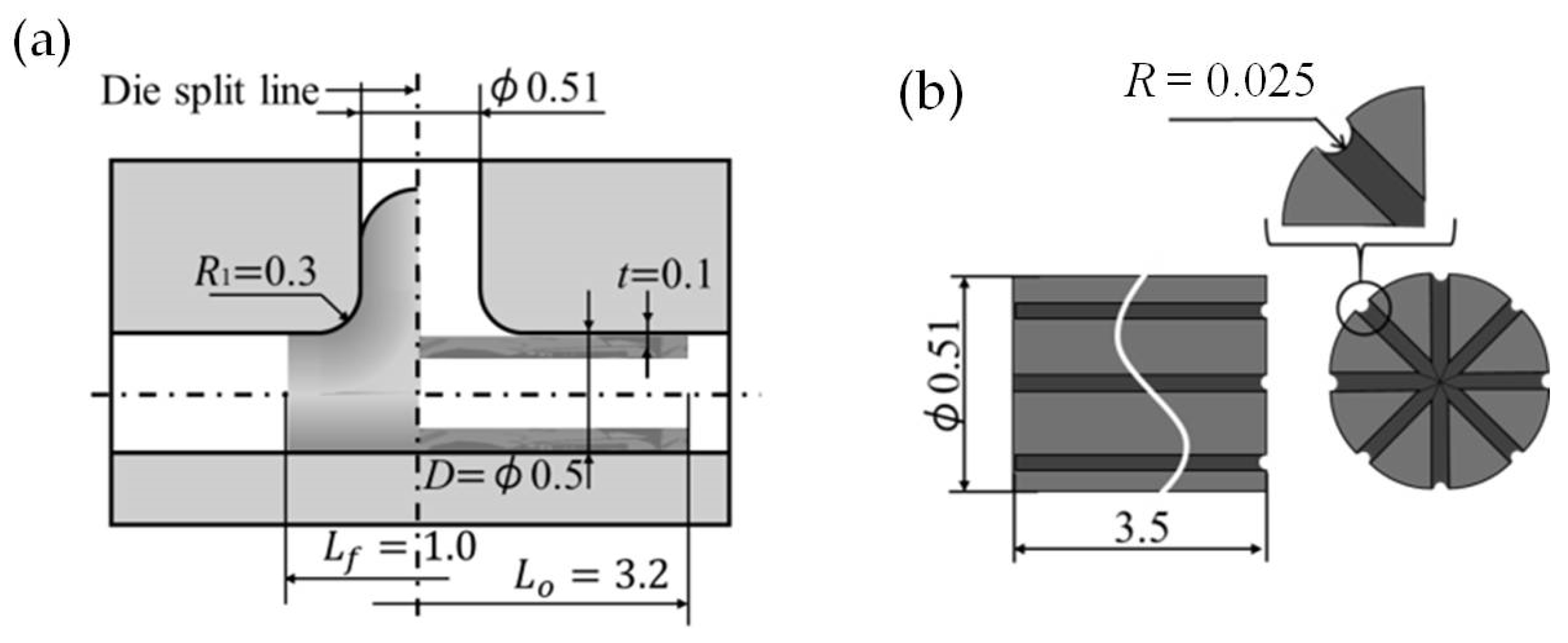
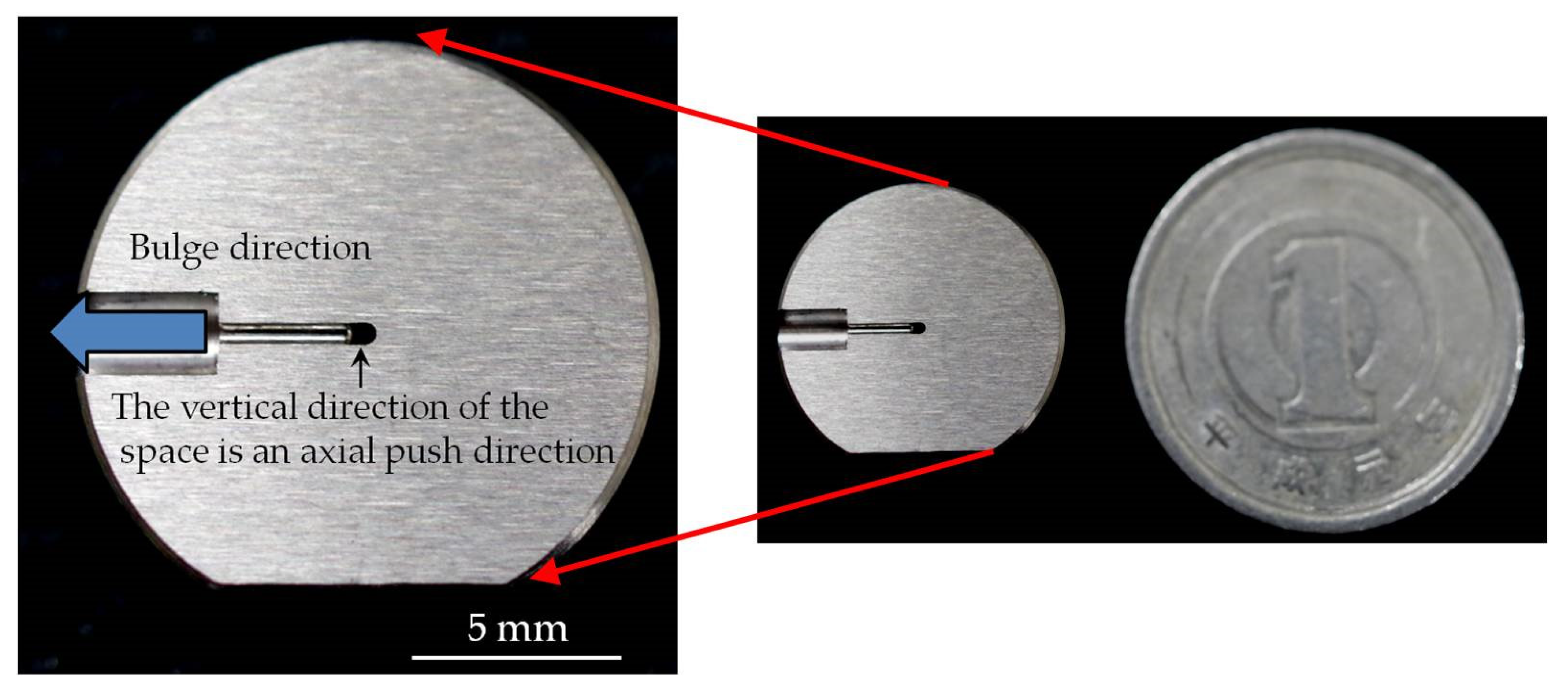

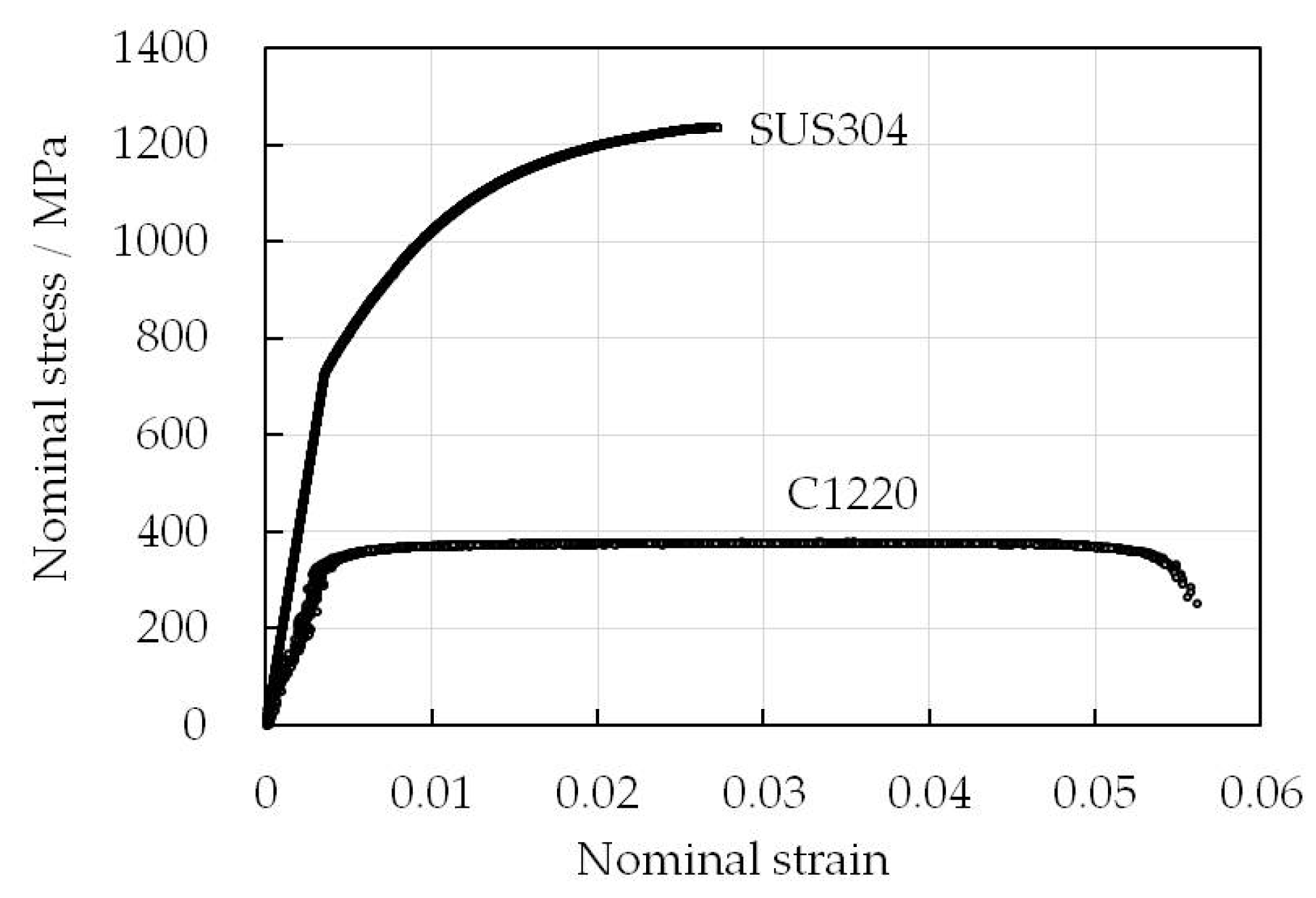

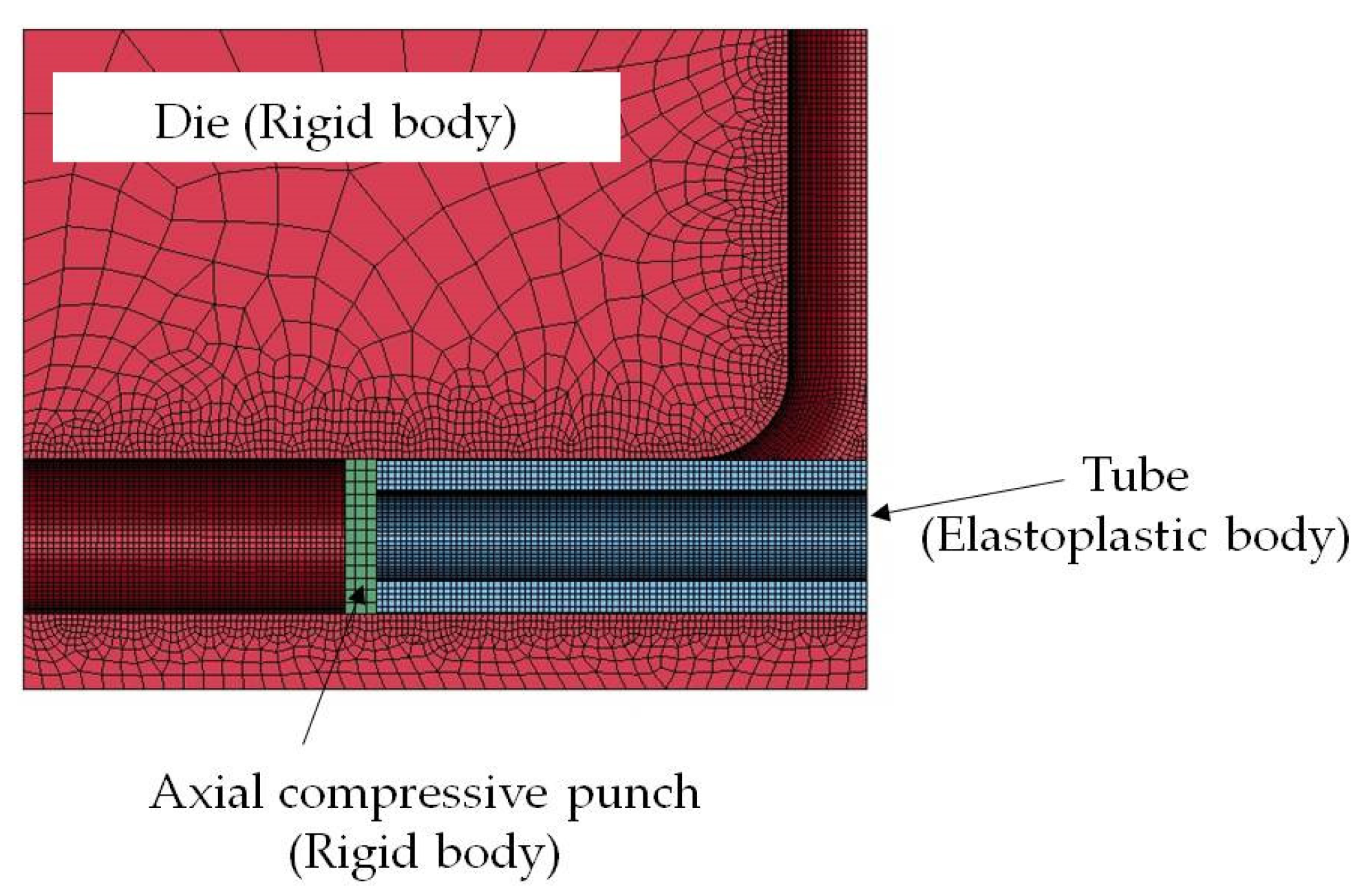
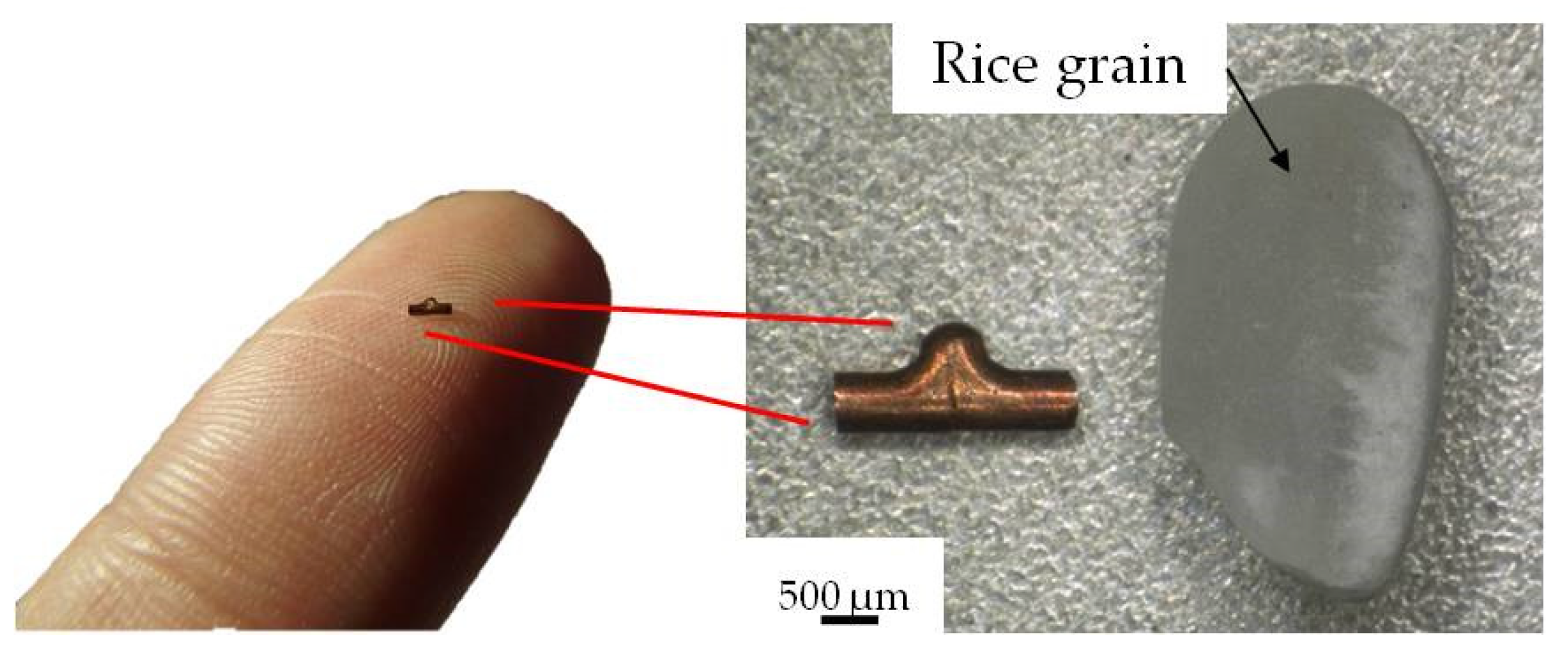
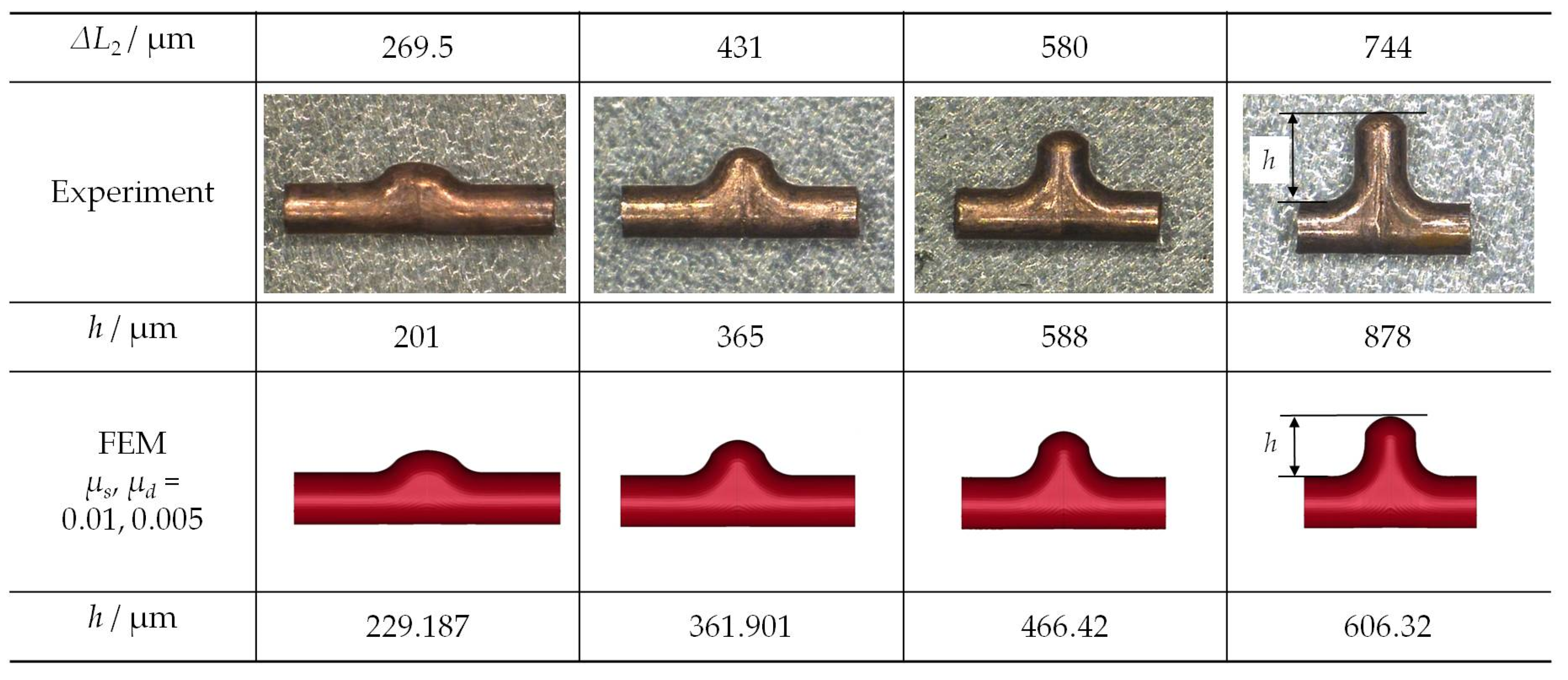
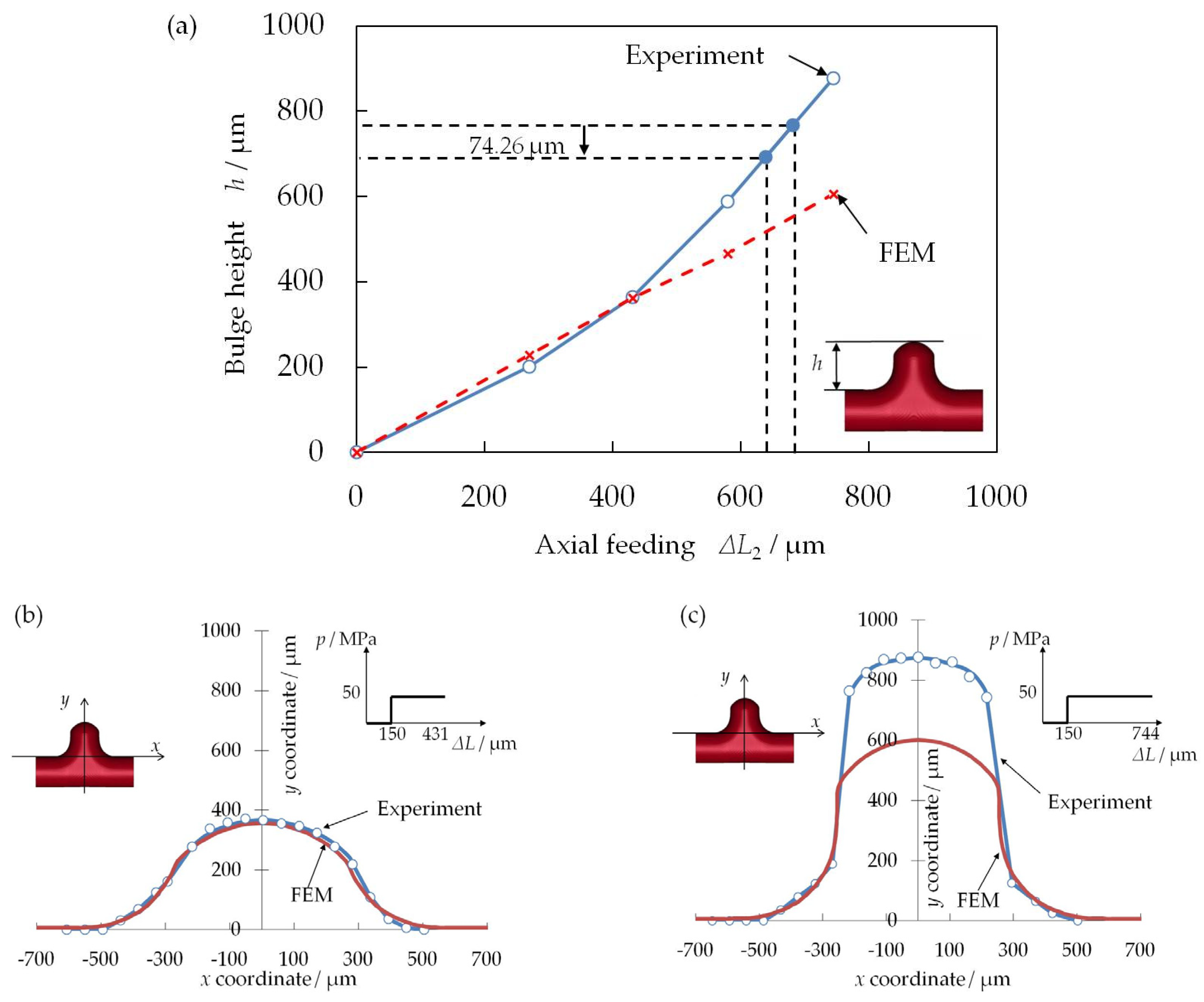


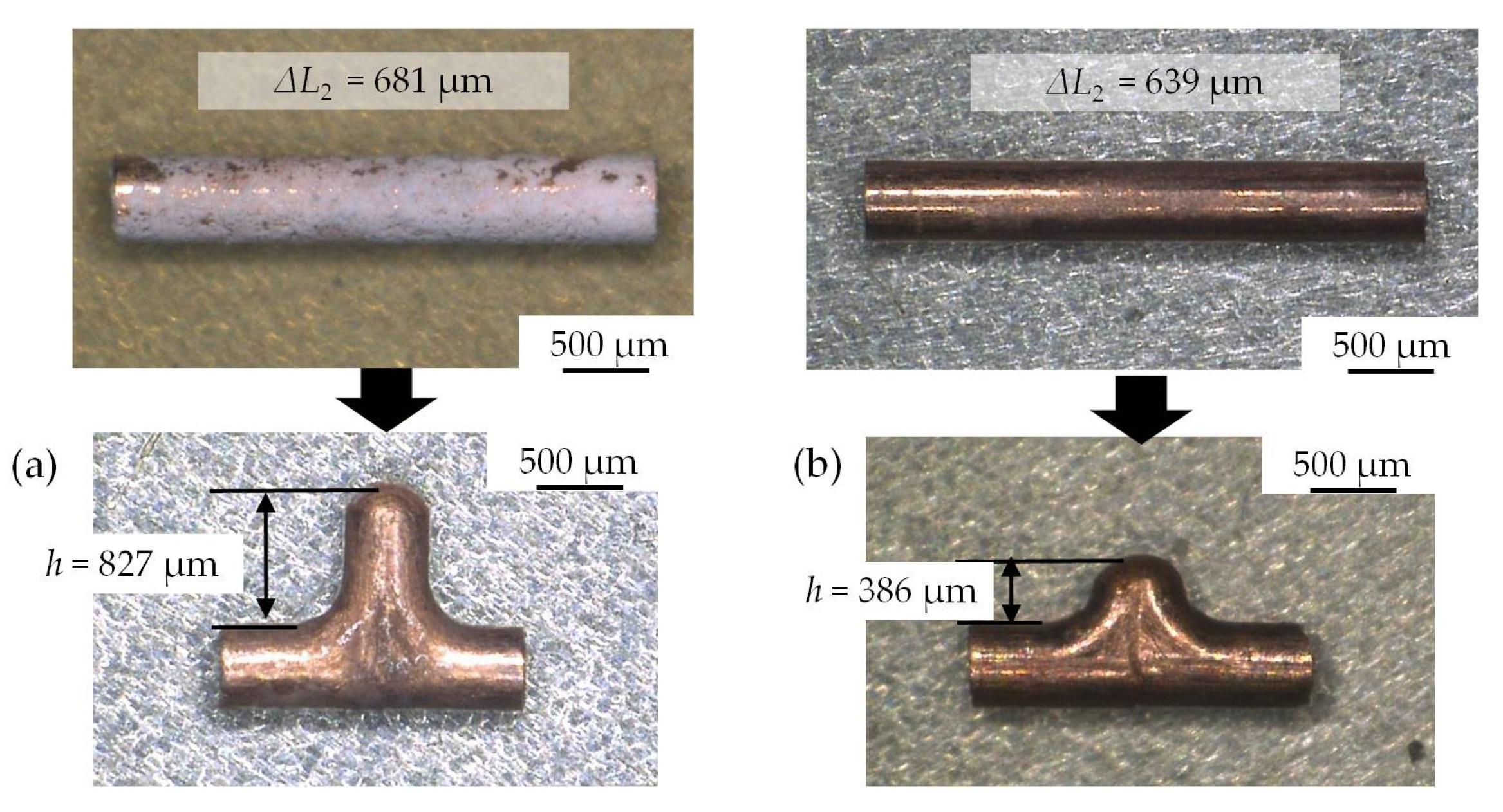
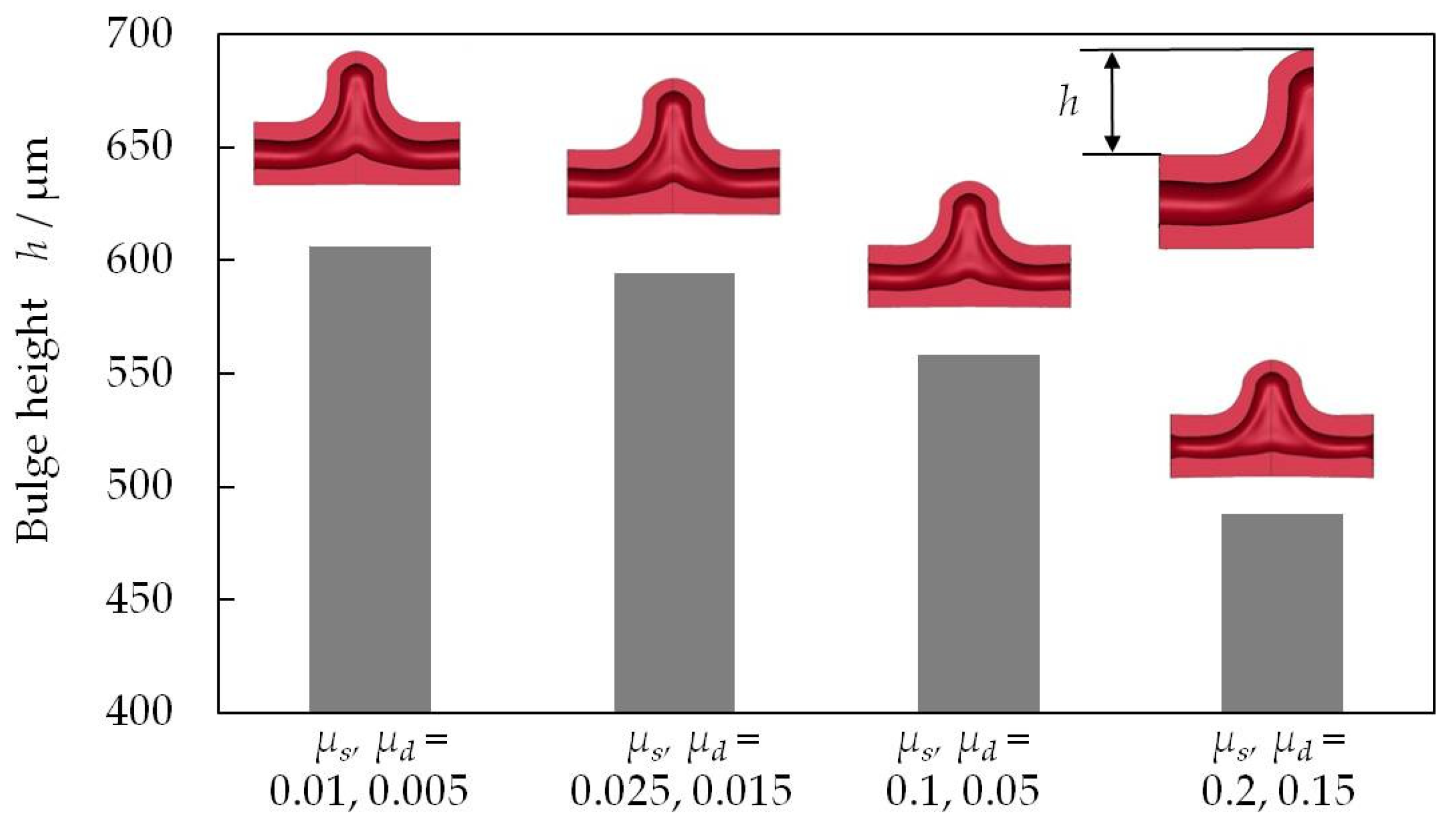

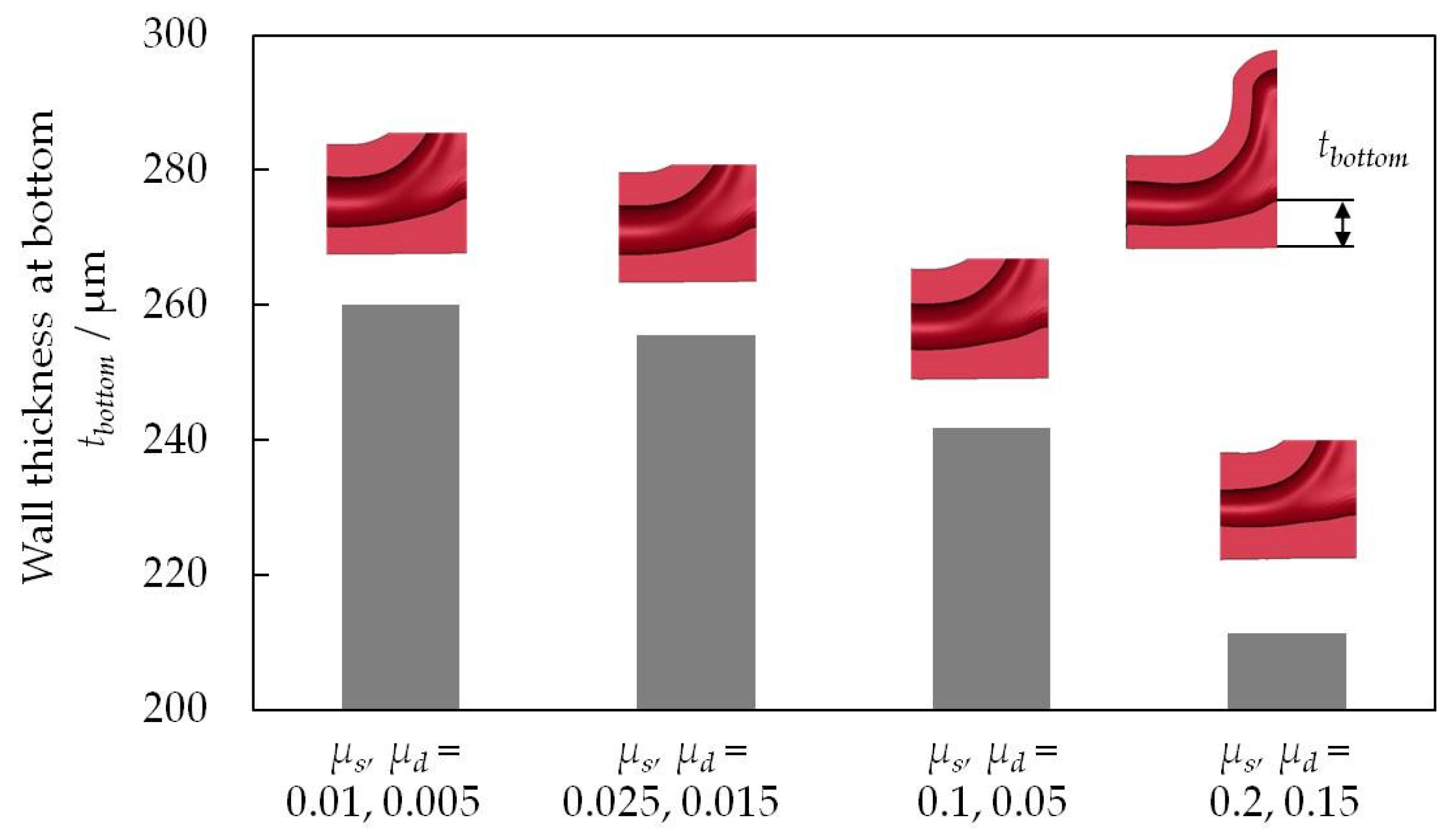
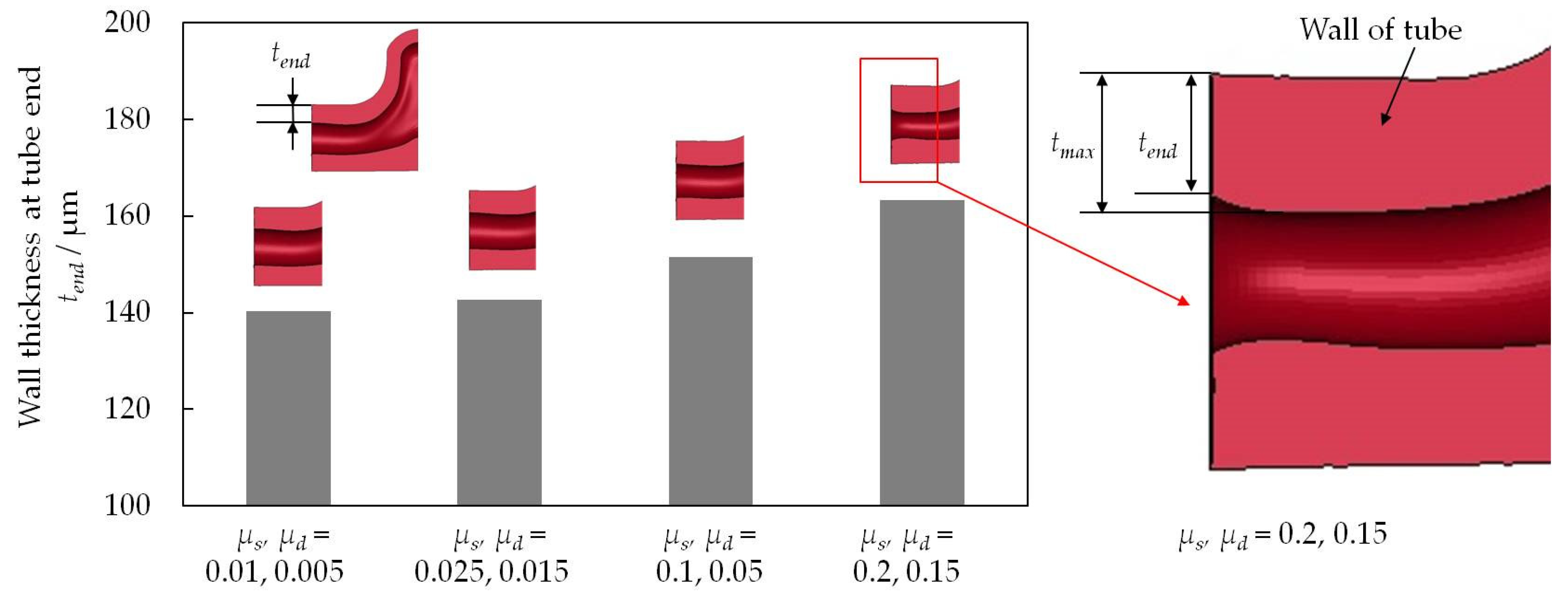
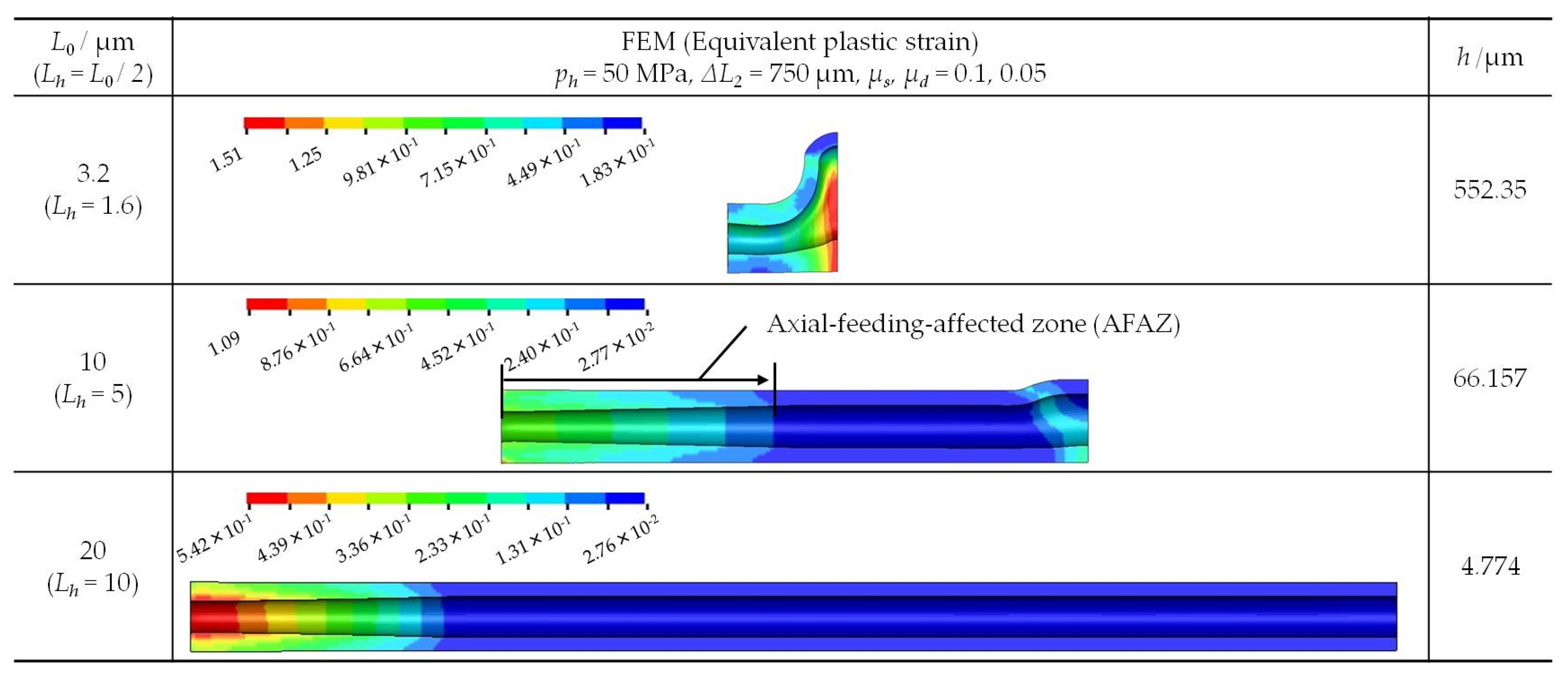
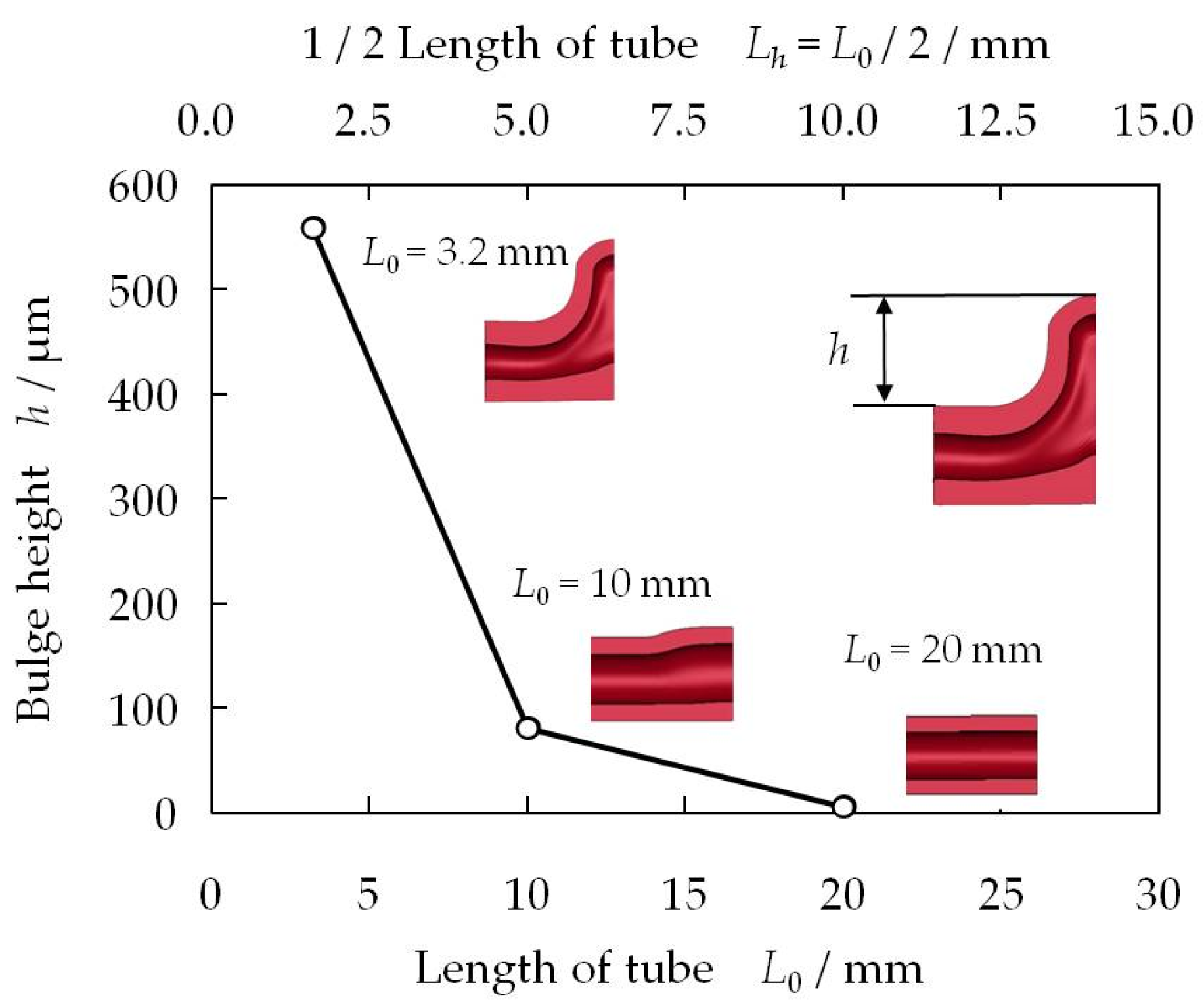
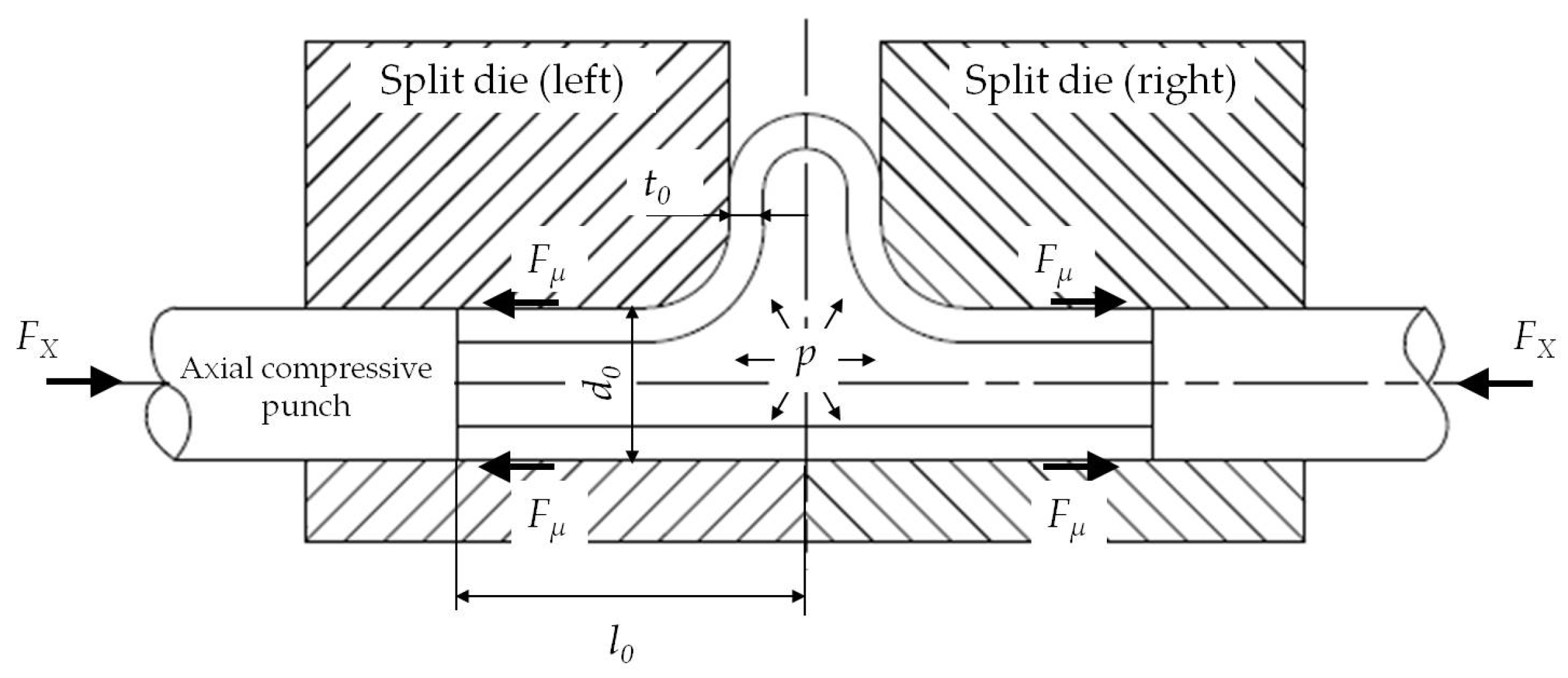

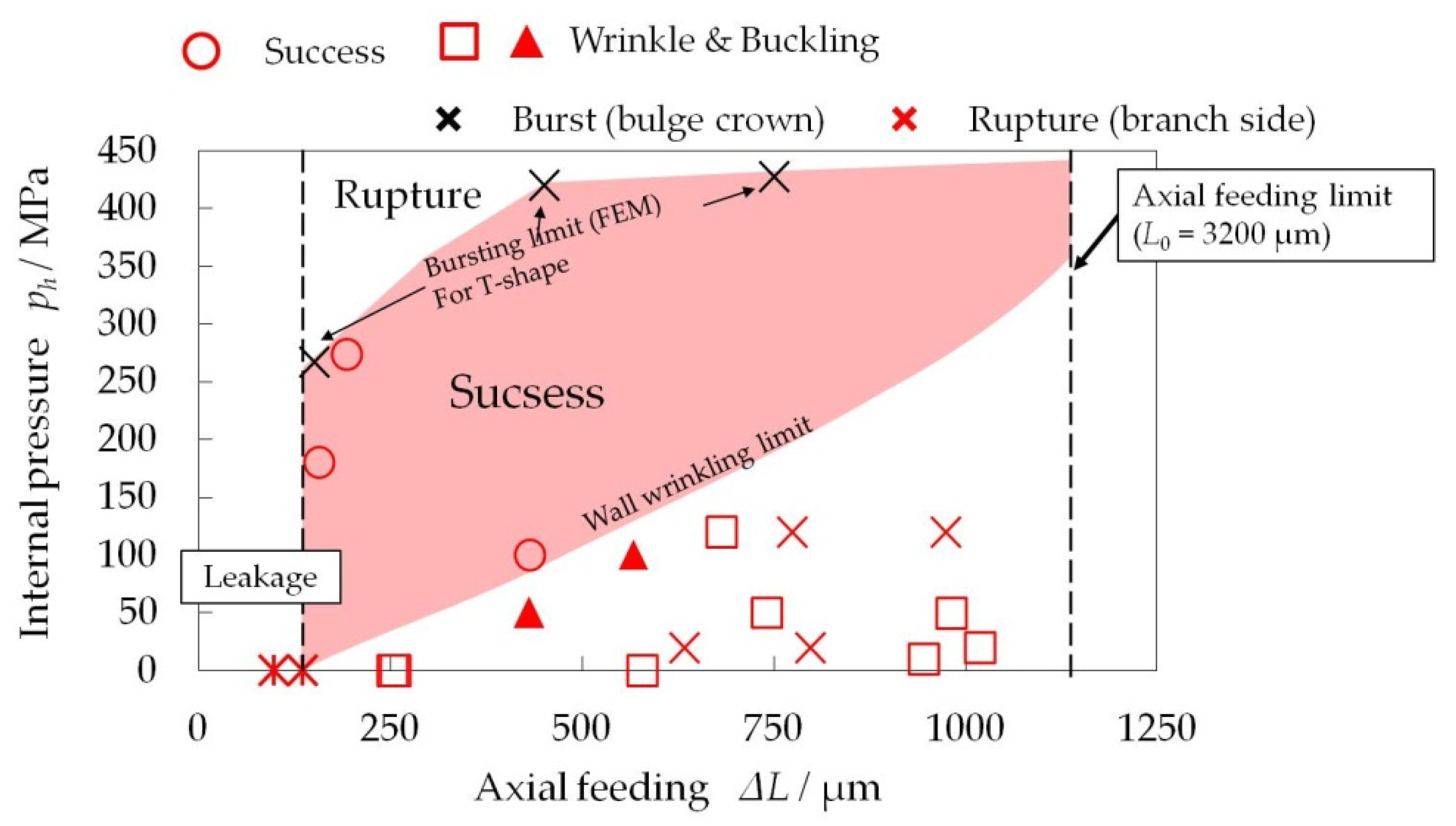
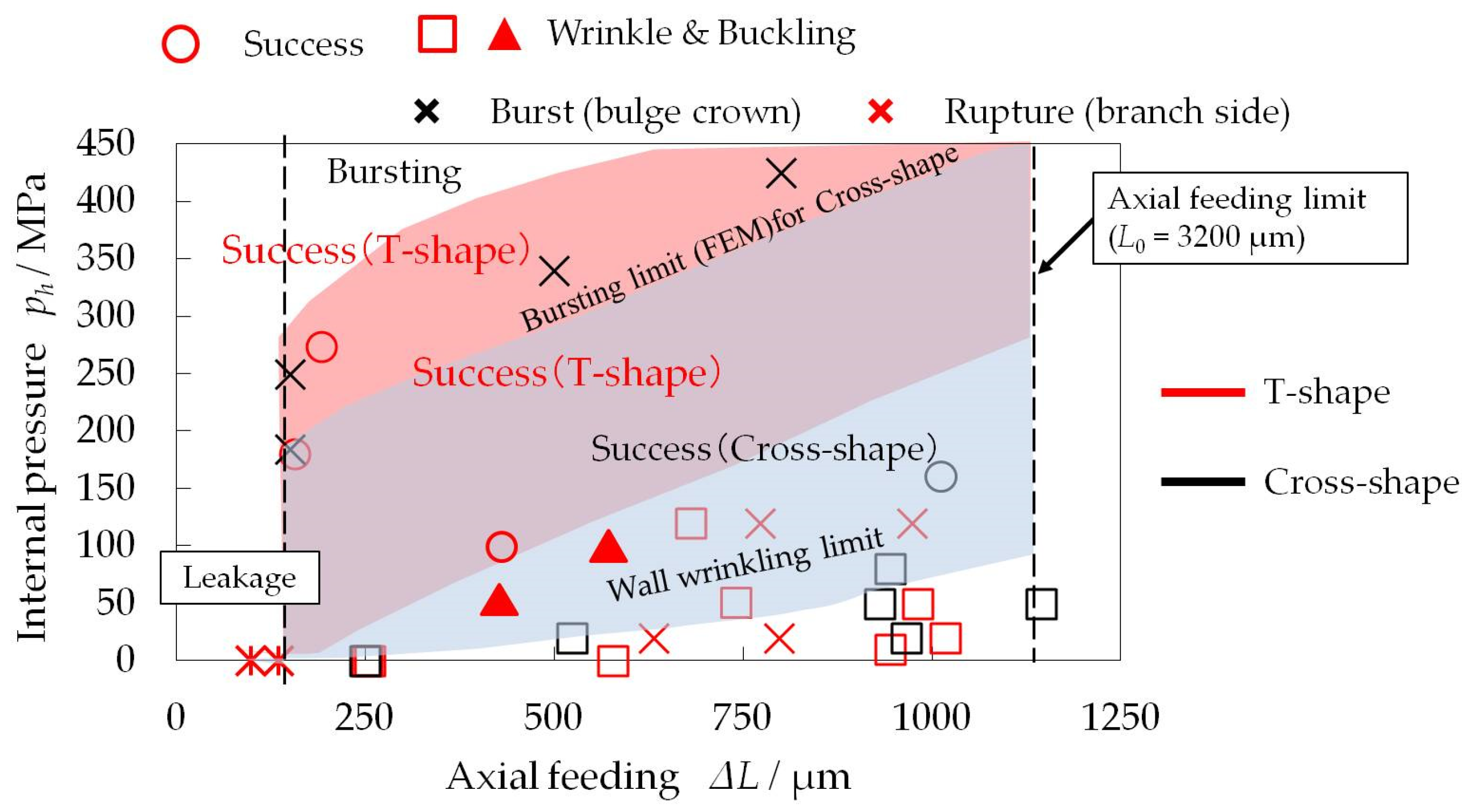
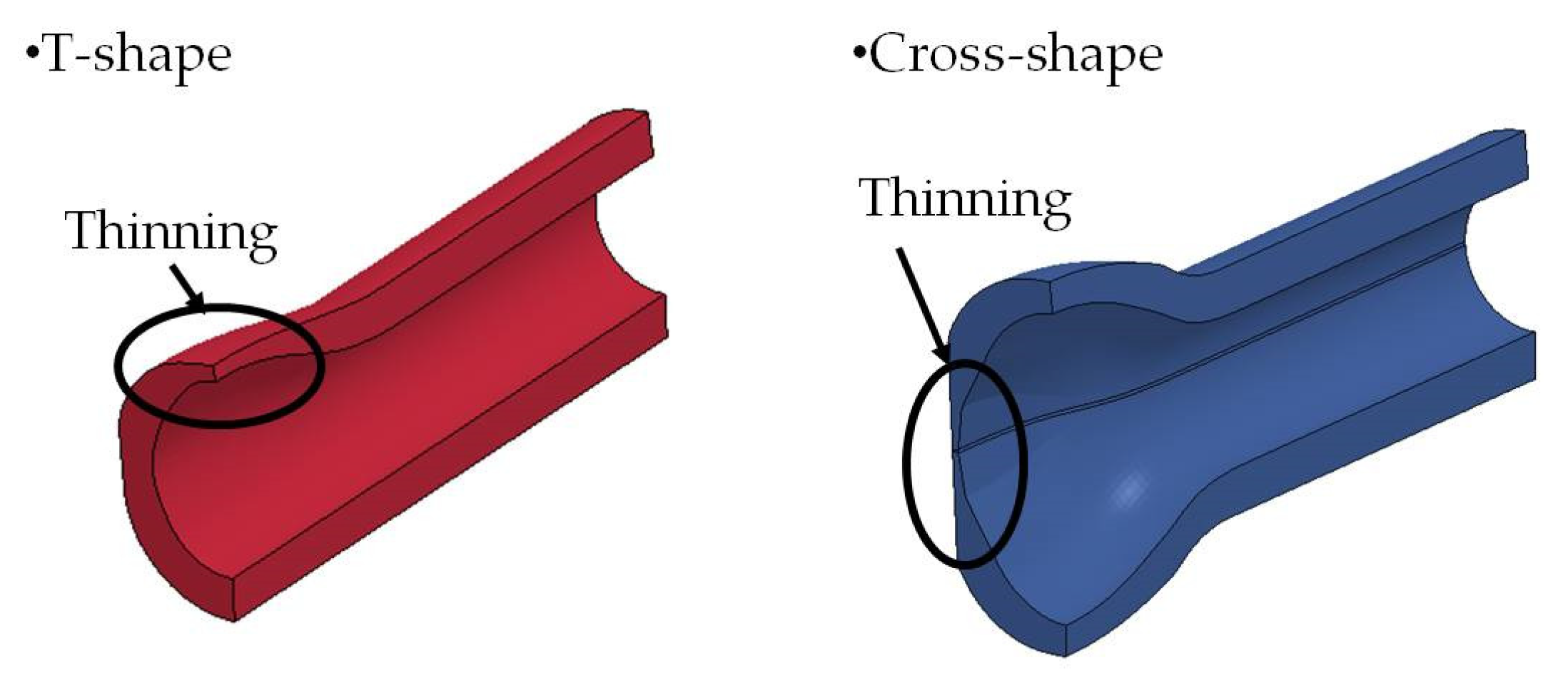
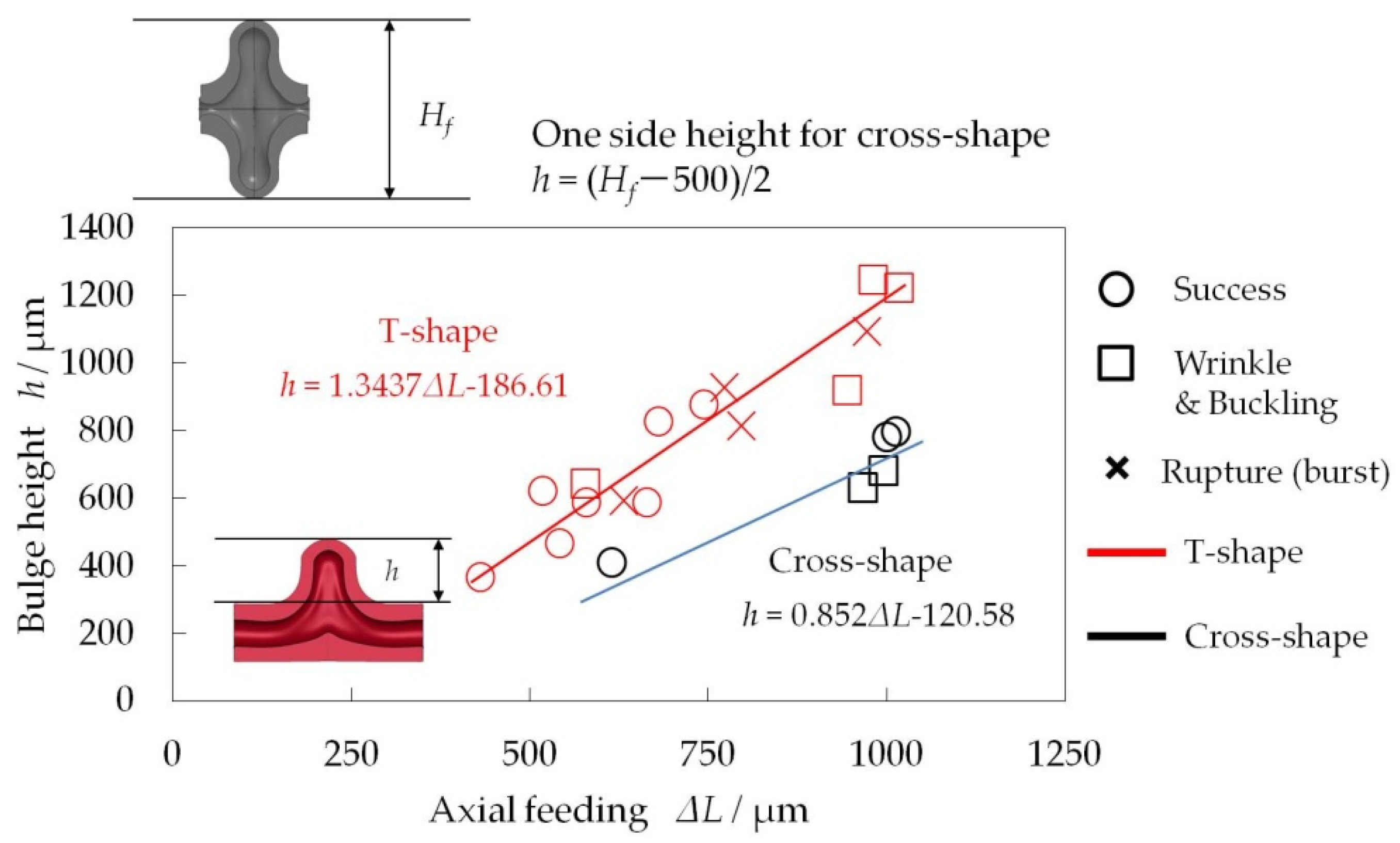
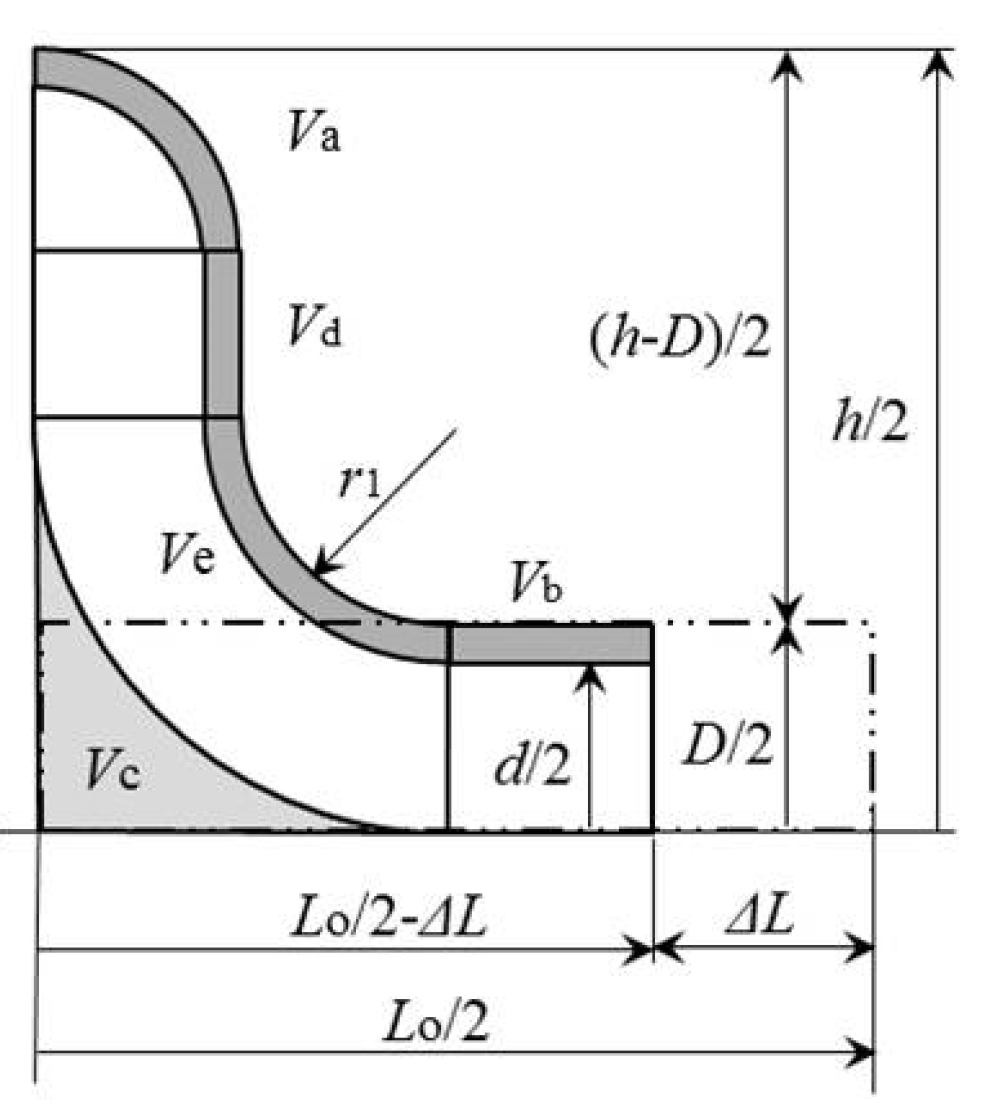
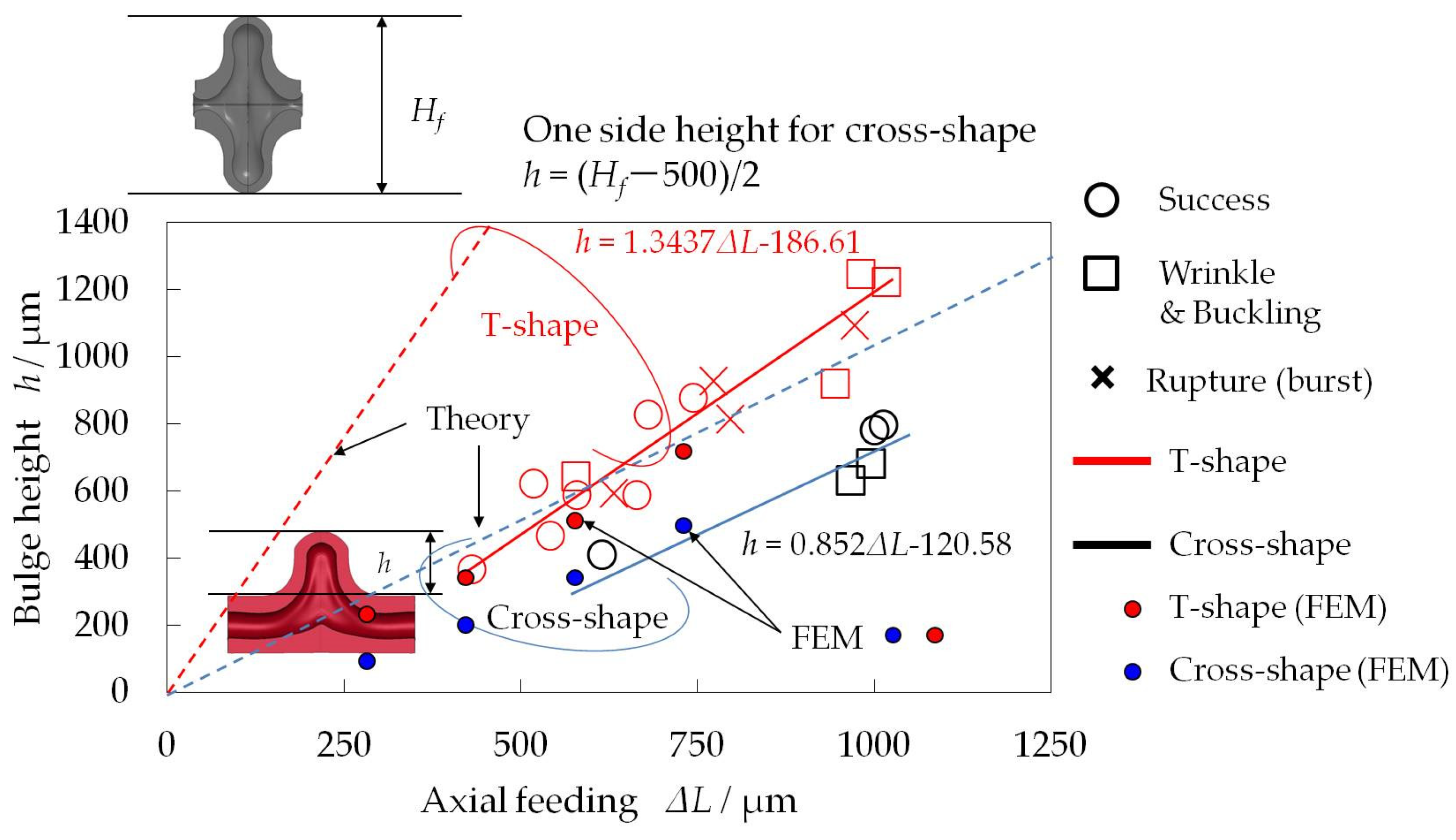

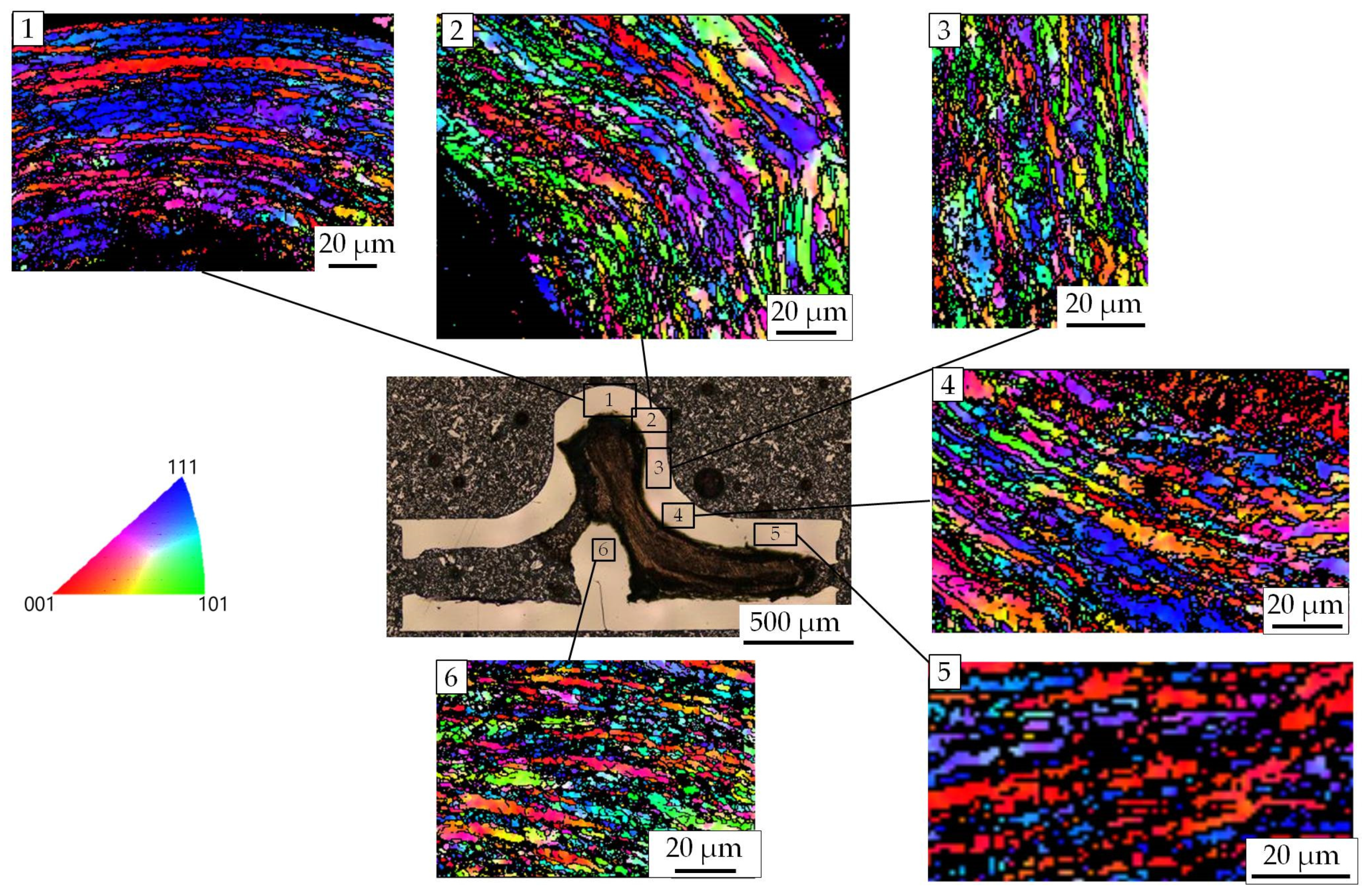
| Material | C1220 |
|---|---|
| Material model | Elastoplastic body |
| Mass density ρ/g cm−3 | 8.89 |
| Elastic modulus E/GPa | 118 |
| Yield stress σy/MPa | 324.47 |
| Poisson’s ratio ν | 0.3 |
© 2020 by the authors. Licensee MDPI, Basel, Switzerland. This article is an open access article distributed under the terms and conditions of the Creative Commons Attribution (CC BY) license (http://creativecommons.org/licenses/by/4.0/).
Share and Cite
Yasui, H.; Yoshihara, S.; Mori, S.; Tada, K.; Manabe, K.-i. Material Deformation Behavior in T-Shape Hydroforming of Metal Microtubes. Metals 2020, 10, 199. https://doi.org/10.3390/met10020199
Yasui H, Yoshihara S, Mori S, Tada K, Manabe K-i. Material Deformation Behavior in T-Shape Hydroforming of Metal Microtubes. Metals. 2020; 10(2):199. https://doi.org/10.3390/met10020199
Chicago/Turabian StyleYasui, Hajime, Shoichiro Yoshihara, Shigeki Mori, Kazuo Tada, and Ken-ichi Manabe. 2020. "Material Deformation Behavior in T-Shape Hydroforming of Metal Microtubes" Metals 10, no. 2: 199. https://doi.org/10.3390/met10020199
APA StyleYasui, H., Yoshihara, S., Mori, S., Tada, K., & Manabe, K.-i. (2020). Material Deformation Behavior in T-Shape Hydroforming of Metal Microtubes. Metals, 10(2), 199. https://doi.org/10.3390/met10020199






